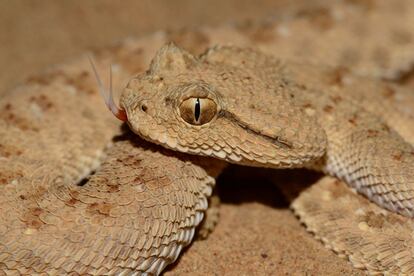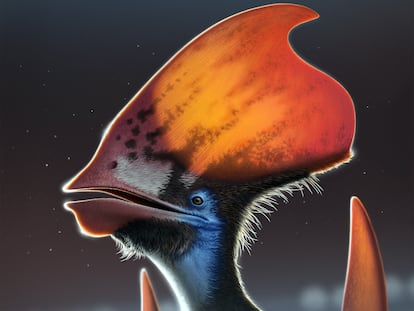First global study of reptile species shows 21% are in danger of extinction
Some 1,829 types of turtles, crocodiles, lizards and snakes are at risk of disappearing


A study published this Wednesday in Nature evaluated 10,196 species of reptiles (there are 11,000 in documented existence in total) and found that 21.1% are threatened with extinction.
The groundbreaking news has been a long time coming. The study was conducted over 15 years, with the collaboration of 961 scientists from 24 countries. And obtaining funding was not the easiest - as American zoologist Bruce Young, co-director of the study, says somewhat ruefully: “Reptiles are less charismatic than mammals or birds… there is not much love for snakes.”
Indeed, says the expert, negative feelings about reptiles in general has contributed to the pre-existing vacuum about the degree of global threat they are subject to.
The study, which also had the participation of the International Union for Conservation of Nature (IUCN) and the organization Conservation International concluded that 1, 829 species of turtles, crocodiles, lizards and snakes are at risk of disappearing from the face of the Earth.
Young, who is a member of the non-governmental organization NatureServe, notes that it’s the first time a global study of extinction threat involving nearly all reptile species has been done. He says that an analysis of birds was carried out in the 1990s, for amphibians in 2003 and for mammals in 2008. “But there was great doubt as to what was happening with reptiles.”
Thanks to this study, we now know that reptiles face a greater threat than birds, whose risk of extinction is measured at 13.6% while 25.4% of mammals and 40.7% of amphibians are in danger of disappearing.
There are variations between reptiles, with 57.9% of the world’s turtles and 50% of crocodiles at risk. The assessment was based on criteria developed by the IUCN which distinguishes between three levels of risk: vulnerable, endangered, and critically endangered.
The main culprit is a certain mammal: the human being. Young lists the causes that put one in five reptile species in check: deforestation, expansion of urban areas, the transformation of land to increase agricultural or livestock area and invasive species introduced by humans. He adds that, in the case of turtles and crocodiles, the main threat is hunting.
Climate change is also threatening reptiles, such as where temperature changes skew the male-to-female ratios of offspring within species. “There are some species for which climate change is already a [clearly discernible] threat, such as inhabitants of islands that are threatened by rising sea levels,” explains Young, Overall, however, climate change impacts are difficult to assess because they occur over a long period of time.
The study indicates that threatened reptiles are concentrated in Southeast Asia, West Africa, northern Madagascar, the northern Andes region and the Caribbean; as well as the Kalahari, Karoo and Sahara deserts; northern Eurasia; and the Rocky Mountains and northern North America. It found that 30% of reptiles living in forested areas are at risk of extinction compared to 14% of those living in arid habitats.
Within this, researchers found that existing efforts to preserve more popular species of birds and mammals that depend on forest ecosystems have helped to protect reptiles.
“Habitat protection is essential to buffer reptiles, as well as other vertebrates, from threats such as agricultural activities and urban development,” adds Young.
The study authors caution that urgent and targeted conservation measures are still needed to protect some of the most endangered reptile species, such as endemic island lizards that face risk from deforestation and from ‘invasive’ mammals introduced by humans.
Sean T. O’Brien is president of NatureServe. He says that “reptiles are fascinating creatures and play indispensable roles in ecosystems around the planet.”
“We all benefit from their role in pest control and in serving as food for birds and other animals.”
Among the conservation strategies that are considered most important to prevent the extinction of reptiles, the study emphasizes increasing protected areas on the planet, to prevent further deforestation and soil transformation.
“The hundreds of threatened reptiles currently found entirely outside protected areas underscore the need for important site-specific safeguards,” concludes the Nature study. It also points out the need to mitigate introduced species, saying “introduced mammals on the islands threaten 257 species of reptiles (2.8% of all reptiles), which requires continuous campaigns to eradicate them.”
Another of the study’s lead authors, Miguel Fernández, who is a postdoctoral researcher at the German Center for Integrative Biodiversity Research (iDiv) insists that there must be investment in conservation activities that specifically targets reptiles:
“Our responsibility is to leave future generations with a planet equal to or better than the one we are living on.”
Tu suscripción se está usando en otro dispositivo
¿Quieres añadir otro usuario a tu suscripción?
Si continúas leyendo en este dispositivo, no se podrá leer en el otro.
FlechaTu suscripción se está usando en otro dispositivo y solo puedes acceder a EL PAÍS desde un dispositivo a la vez.
Si quieres compartir tu cuenta, cambia tu suscripción a la modalidad Premium, así podrás añadir otro usuario. Cada uno accederá con su propia cuenta de email, lo que os permitirá personalizar vuestra experiencia en EL PAÍS.
¿Tienes una suscripción de empresa? Accede aquí para contratar más cuentas.
En el caso de no saber quién está usando tu cuenta, te recomendamos cambiar tu contraseña aquí.
Si decides continuar compartiendo tu cuenta, este mensaje se mostrará en tu dispositivo y en el de la otra persona que está usando tu cuenta de forma indefinida, afectando a tu experiencia de lectura. Puedes consultar aquí los términos y condiciones de la suscripción digital.
More information
Últimas noticias
ICE raids trigger school absenteeism and traumatize children: ‘They have been forced to leave their childhood behind’
Mexico’s missing people crisis casts a shadow over World Cup venue
Can cheese protect brain health? This is what the science says
Maude Apatow, from acting in ‘Euphoria’ to directing: ‘There are many films that you can tell weren’t written by someone young’
Most viewed
- Christian Louboutin: ‘Young people don’t want to be like their parents. And if their parents wear sneakers, they’re going to look for something else’
- US sanctions against jailed cartel leader ‘El Marro’ highlight Mexico’s lack of control over its prisons
- Cartels in Mexico take a leap forward with narco-drones: ‘It is criminal groups that are leading the innovation race’
- Liset Menéndez de la Prida, neuroscientist: ‘It’s not normal to constantly seek pleasure; it’s important to be bored, to be calm’
- ‘El Limones’ and the growing union disguise of Mexican organized crime










































